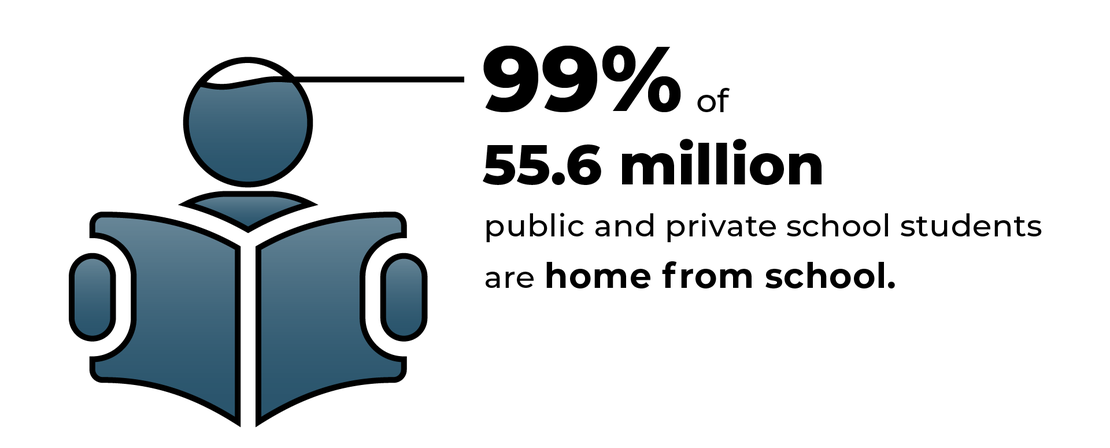In late 2019, we started seeing stories about a mysterious new virus in the Wuhan region of China. Three months later, that virus has become a global pandemic affecting 868,100 people in at least 171 countries infected and at least 43,000 dead, according to The New York Times.
Here in America, the COVID-19 coronavirus has impacted every aspect of society, including our schools. According to Education Week, as of March 31, at least 124,000 schools have closed, affecting at least 52.6 million students. That’s 99% of the 55.6 million public and private school students in the U.S., according to the National Center for Education Statistics.

In this time of crisis, our educators and educational institutions will play a critical role in helping to make sure all students are able to continue learning in spite of these difficult circumstances. Remote learning is one important way that schools and districts can help to ensure their students do just that.
Remote learning describes any type of instructional situation in which the student is not sharing the same physical space as the teacher. As the internet and new educational technology have provided greater connectivity and flexibility, remote learning has become an increasingly viable option.
That’s not to say that remote learning is a perfect solution for all schools and all students. In her recent New York Times Article, ‘Coronavirus is Shutting Schools. Is America Ready for Virtual Learning? Dana Goldstein points out five of the biggest challenges posed by remote learning
Not every home has computers or high-speed internet.
The vast majority of households with children have broadband internet, but there are still big disparities by income, race and the education level of parents. Low-income families are more likely to rely on smartphones for internet access, and children in those households may not be able to use more sophisticated learning software that requires a tablet or computer. It is not unusual, educators say, for siblings to try to complete their schoolwork on a single cellphone.
Younger children require a lot of adult supervision.
Younger students need help to learn online ‘ lots of help. Parents may need to assist their child with turning on a device, logging into an app, reading instructions, clicking in the right place, typing answers and staying on task. Even the tech-savviest adult will find this difficult while working from home at the same time ‘ a more common scenario as the coronavirus spreads. Parents who continue to work outside the home when schools are closed will need to arrange child care, where technical help could be scarce.

Even great teachers lack expertise in creating online lessons.
While there are lots of exceptional teachers, not all of them are ready to move their instruction online. Online lessons need to have more clearly written-out themes and directions for students, said Sarah Giddings, a teacher at WAVE, a high school in Ypsilanti, MI’ ‘You can be a fantastic teacher, but writing curriculum is hard, she said’Educators warn against using learning tools that make it difficult to log in, are inaccessible via mobile devices or require downloading special software. Remote learning, they say, should simply require signing into a website. Students with special needs can be the hardest to teach virtually.

Christopher W. Bakk, a social studies teacher at Turning Point Academy in Racine, Wis., has taught special education students both in-person and remotely, via the Wisconsin eSchool Network. Some of those students have behavioral issues and thrive online because there are fewer social distractions, he said. But others find it difficult to have less direct access to teachers and peers. ‘The self-discipline is a struggle, Mr. Bakk said. In addition, many students in this generation are nervous about speaking over the phone, which Mr. Bakk said can be a crucial tool for teachers to check on students who are learning at home.
Schools provide more than academic skills.
Even when the devices, WiFi, software, lesson plans and adult supervision are all in place, a lot is lost when schools transition students to remote learning. Many children rely on schools for free or affordable meals, for counseling and for after-school activities while parents work. When schools are closed, children lose a crucial social outlet. And families, especially those who work in the service sector and cannot easily adjust their schedules, can struggle to find appropriate child care. ‘If you think about it, the school is a city we provide to kids, said Nate Ridgway, a social studies teacher in Beech Grove, Ind. When that city shuts down, he said, no online learning platform can replace all the structure and vibrancy that is lost.
Many educators and social scientists believe that remote learning is the future of education. And while implementing such a system does present its share of challenges as Dana Goldstein noted, this innovative learning approach also offers some tremendous opportunities, including:
The ability to personalize learning/instruction
In the classroom, teachers need to instruct in a way that reaches and engages all their students. By teaching to everyone, they can sometimes end up reaching no one. Remote learning can differentiate instruction to reach and engage students on their individual levels. The result is a stronger, more personal connection to the material and the instructional platform.
The ability to more accurately measure and monitor student performance
By offering frequent online assessments and other ongoing measures of individual student engagement and performance, remote learning provides teachers and administrators with a wealth of personalized, real-time data analytics. This information can be used in instructional decision making, including targeting assignments to areas where students need additional work.
The ability to give students more control of their learning
Remote learning is a more student-focused and student-directed approach. Teachers have found that giving their students more control and allowing them to work at their own pace[MR1] [MR2] [MR3] can lead to greater engagement, better performance, and a deeper sense of responsibility. Remote learning also gives students a sense of freedom, since they can learn anywhere at any time
The ability to promote collaborative learning
Remote learning uses technology to keep everyone connected. Teachers can stay connected to their students. Students can stay connected to their classmates; they can even work on projects together, developing their collaborative learning and interpersonal communication skills. This type of collaborative approach has proven to be an effective way to keep students engaged.
The ability to identify and support struggling students
Since educators and administrators can monitor student performance in real-time, it becomes much easier to recognize when students are struggling and the specific areas in which they’re struggling. Once these connections are made, it is also easier to intervene. And because remote learning is personalized, students aren’t forced to keep up with higher-achieving classmates.